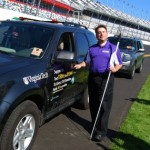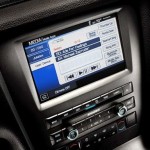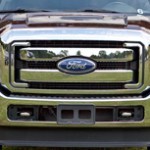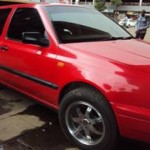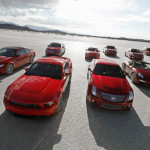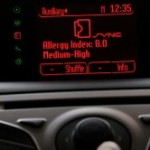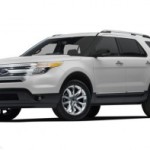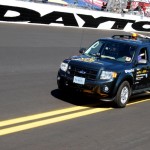 A Ford Escape poking along at 25 mph isn’t usually the most exciting event on the track at the Daytona International Speedway. Consider that the driver is blind, however, and that slow-moving Ford is an example of how technology can grant autonomy.
A Ford Escape poking along at 25 mph isn’t usually the most exciting event on the track at the Daytona International Speedway. Consider that the driver is blind, however, and that slow-moving Ford is an example of how technology can grant autonomy.
Mark Riccobono, a blind executive at the National Federation of the Blind, handled the curves, avoided obstacles thrown in his path from a van ahead of him and then passed that van. He did it in a vehicle built by students using off-the-shelf technology.
“That was fun because nobody expected that we’d do that,” Riccobono said. “We kept exactly what we were going to do on the track, we held that close to the vest and even our members didn’t know that was going to happen.”
Although we’re a long way from the day when we’ll see Riccobono joining us on the morning commute, the technology that might allow him to do so could help the visually impaired in countless other situations. And it might make the cars the rest of us drive a little smarter and safer too.
Riccobono’s adventure at Daytona earlier this month wasn’t a stunt with engineers controlling the car from a lab somewhere. It was part of the Blind Driver Challenge, a partnership between the federation and engineers at Virginia Tech’s Robotics and Mechanisms Laboratory. Although some of the systems in the Escape were developed for the DARPA Urban Challenge autonomous car race, Riccobono was in complete control of the vehicle at all times.
“This is awesome because it means we built real technology that put real responsibility in the hands of blind people, and with that responsibility comes opportunity,” he told Wired.com.
Second Sight
“In the Blind Driver Challenge the objective was not for the vehicle to drive the blind person, but for the blind person to drive the vehicle,” said Jesse Hurdus, a software engineer at TORC. The company provided the vehicle control hardware in the Escape.
“In order to actually drive this route, the blind driver needs to have a thorough understanding of their immediate environment,” Hurdus said. “In essence, we have replicated the eyes of a human and the parts of the human brain and nervous system responsible for basic driving perception with sensors, hardware and software all built into the vehicle itself.”
Even though he was unable to see his immediate surroundings, Riccobono had all the information necessary to avoid everything the guy in the van threw at him.
The first line of defense was a GPS unit with a general sense of the road ahead. Scanning-laser range-finders and cameras gave the car virtual vision, while an Inertial Measurement Unit mimicked the inner ear. TORC’s hardware synthesized all the information into a “picture” of the environment around the Escape. It’s similar to the inputs used to control an autonomous vehicle, but instead of controlling the car the sensors sent information directly to the driver.
For the Blind Driver Challenge, a vibrating seat, called SpeedStrip, told Riccobono whether to speed up or slow down depending on what part of the seat rumbled. Gloves with tiny vibrating motors, called DriveGrip, let Riccobono know what to do with the steering wheel.
As impressive as the setup is, vibrating seats and gloves are instructional cues, similar to a sighted person in the passenger seat saying, “Turn left! Slow down!” The next challenge is developing an informational non-visual interface that allows the driver to perceive the environment and make independent decisions.
The students and engineers at Virginia Tech are working on such a solution. Called AirPix, it’s like an air hockey table but with airflow controllable for each individual pinhole. By varying how much air comes out of each pinhole, AirPix can create refreshable Braille or even a tactile “image.”
The students and faculty at Virginia Tech are confident they’ll create an interface that will gain widespread acceptance because they’ve involved the blind in much of the development.
“Working with the blind was one of the most important keys to our success, I believe,” said Dr. Dennis Hong, director of Virginia Tech’s Robotics and Mechanisms Laboratory. Hong and his students worked with blind engineers, added a blind student to the team and even stayed overnight at the NFB to learn what it’s like to eat, sleep and live as a blind person.
“This immensely helped us to come up with the ideas for the interfaces,” Hong said, “but we still have a long way to go, as this is just the beginning.”
The Road to Autonomy
With technology like AirPix, Hong estimates that blind drivers could be capable of travel on public roadways within five to 10 years. Getting blind people behind the wheel, however, isn’t the primary goal of the Blind Driver Challenge.
“Will the society be ready by then? Probably not,” he said. “Besides technological challenges, there are too many other problems.”
Sighted drivers might not be comfortable sharing the road with a blind driver, and insurance companies would demand higher premiums. Plus, all that technology is really expensive. Riccobono’s drive aside, the project is more about showing the public what blind people can do and encouraging the development of new technology that helps both the blind and the sighted.
“With just a little bit of help from technology, the blind can accomplish almost anything,” said Hong. “Also, we want to inspire other engineers and scientists to look into this problem of developing technology to help the blind.”
A little more than a year ago, the Blind Driver Challenge had $5,000 and a go-kart that rumbled so badlythe driver couldn’t detect the vibrations instructing him when and where to turn. Since then, the vehicle has evolved into a high-tech Ford Escape and prerace activities at Daytona.
The next steps are applying nonvisual interfaces developed for the Blind Driver Challenge to appliances, offices and schools.
“In the classroom, as the teacher writes on the blackboard, the blind students will be able to ‘read’ what the teacher writes on the blackboard through our future interfaces,” Hong said. “This is priceless.”
Anil Lewis of the National Federation of the Blind agreed.
“When more people begin to realize that it is possible for a blind person to use technology to access information about the driving environment in a nonvisual manner, there will be a progressive understanding of how this same technology will make it possible for blind students to access their educational environments in new and exciting ways, and for blind adults to access employment opportunities previously thought inaccessible to them,” Lewis said.
Possibilities Are Endless
Just as NASA gave us a man on the moon and a pen that writes upside down, sighted and blind people alike will enjoy benefits from technology developed during the Blind Driver Challenge.
“Besides the immediate goal of developing a car for the blind for independence and freedom, the value for spin-off technology could be huge,” Hong said.
For instance, the lane departure warning systems and active cruise control that are cropping up in high-end cars could benefit from the same technology that helped blind drivers.
“There are many applications in which a sighted person is limited in their ability to operate a vehicle due to lack of vision,” said Hurdus. “We can enhance a person’s normal sensory capabilities with this technology and improve their ability to drive in the dark, or in the fog for example, where traditional human sight fails.”
For Riccobono, Daytona was just the beginning of the journey for getting blind drivers onto the road. “It will take a lot of time and energy to convince people,” he said. “We know that will come, and we’re prepared for that. We’re used to changing laws and advocating and educating the public, but the first thing is we need to get this technology where it needs to be.”
Most importantly, by putting a blind person in control of a car, the Blind Driver Challenge also put the NFB in control of shaping policy and technology for the blind. Said Riccobono, “The horizons of independence are determined by us, not by someone else, so we really get to define what the limits of the possibilities are.”
Photos and video: Virginia Tech University
Source: http://www.wired.com/autopia/2011/02/high-tech-car-allows-the-blind-to-drive/

